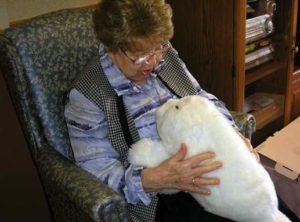By Michelle Seitzer
It started with a life-sized Golden Retriever toy named Biscuit.
The robotic pet, made by the popular toy manufacturer, Hasbro, could bark, sit, lay down, and turn his head. When he was introduced to residents and staff in a Front Porch memory care community in North Carolina, word traveled quickly to Davis Park, Executive Director for Front Porch’s Center for Innovation and Wellbeing. “Davis, we have to get one,” his staff insisted.
Unfortunately, Biscuit had been discontinued; at $400, the product was too expensive and wasn’t selling. Park found one on eBay for $200, and though he was hesitant, he purchased it. They saw immediate engagement, however, when a resident became upset about the “dog” standing on the table, he knocked it to the floor. Biscuit didn’t work right after that, which only led to increased frustration instead of the previously positive response.
But the Front Porch team had been so impressed with the reactions to Biscuit. His presence had a calming effect. Still, they couldn’t find anything comparable on the market.
Enter Paro, a robotic baby harp seal that retailed for $6000-7000, or could be leased for $200-400 a month. Though Paro had been around for about 9 years, Park was more than skeptical, especially considering the cost. “When I first saw it, I thought it was ridiculous,” he said. He wondered how it would work. He reached out to Paro’s inventor and asked if he would consider pilot testing the robotic seal in senior living, something he had never done before. He agreed, and Park was able to secure two seals—at no cost.
They planned to introduce Paro (who is actually considered a Class II medical device by the US Food & Drug Administration) to residents in their care center and in one of their memory care communities. But they wanted to do it right, Park said. “Our caregivers did intense training with a licensed robotic therapist,” he explains. Fortunately, she was able conduct her training sessions virtually, teaching staff the importance of infection control and proper washing techniques for Paro, and how to appropriately introduce the furry friend. They set up three intervention conditions and measurements for tracking results.
The results were incredible.
Residents who had been nonverbal for weeks started speaking in full, clear sentences. Anxious residents were noticeably calmer; socially isolated residents were drawn out. Many who had previously spent the day sleeping were more alert and engaged, and some who took psychotropic medications regularly moved to a PRN basis.
Upon seeing these “massively compelling results,” Park reached out to Front Porch foundations to assist with the purchase of 6 more devices. “We wanted to expand the sample,” he said. “We wanted to collect data and metrics to solidify our initial hypothesis.”
Another terrific outcome? The staff really enjoyed finding creative ways to use Paro into the environment, says Park. Paro could redirect an anxious person who was sundowning, eliminating the need for meds and putting everyone around that individual at greater ease. They used Paro for fall prevention, seating him on the laps of residents who often tried, unsafely or unsuccessfully, to stand up from their seat or wheelchair.
Paro is not for everyone, and Park and his staff accept that. “But our caregivers know who will respond to it,” he explains. “And when we asked them, ‘What if we took Paro away?’ we got such an emphatic no in response.” According to the staff, Paro allowed them a new, more compassionate way of getting to know the residents in their care.
Since Paro joined some of the Front Porch communities, they are now offering a number of other solutions for engagement, such as the Music & Memory program and iN2L (It’s Never 2 Late) a tech-teaching program. Park believes these have transformed memory care and are “affordable, accessible, alternative solutions” that maintain dignity as well as provide care in new ways.
And while Park has seen social robotic technology resonate with so many people, he and his team are careful to address fears about robots taking over. “It’s one of the most important messages in this work,” he says. But when you have someone who will not respond to human contact and is experiencing anxiety and self-isolation because of it, Paro can offer caregivers and individuals “the tools they need fill the gaps.”


